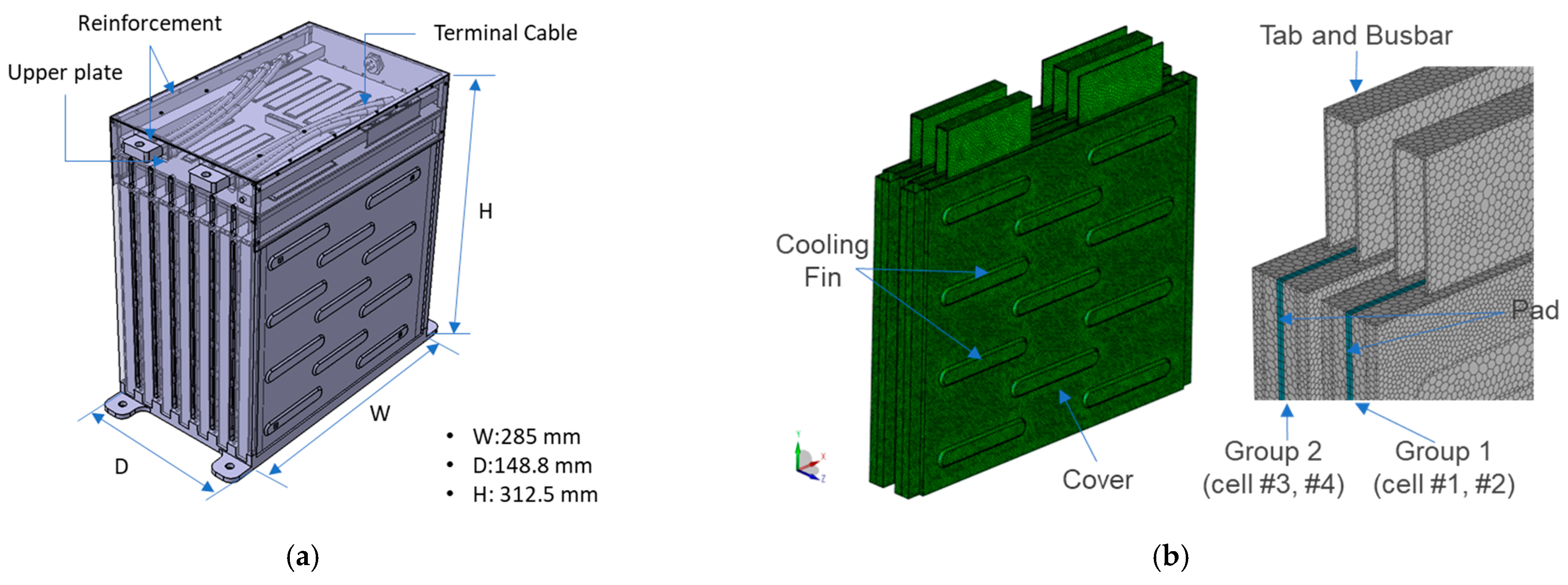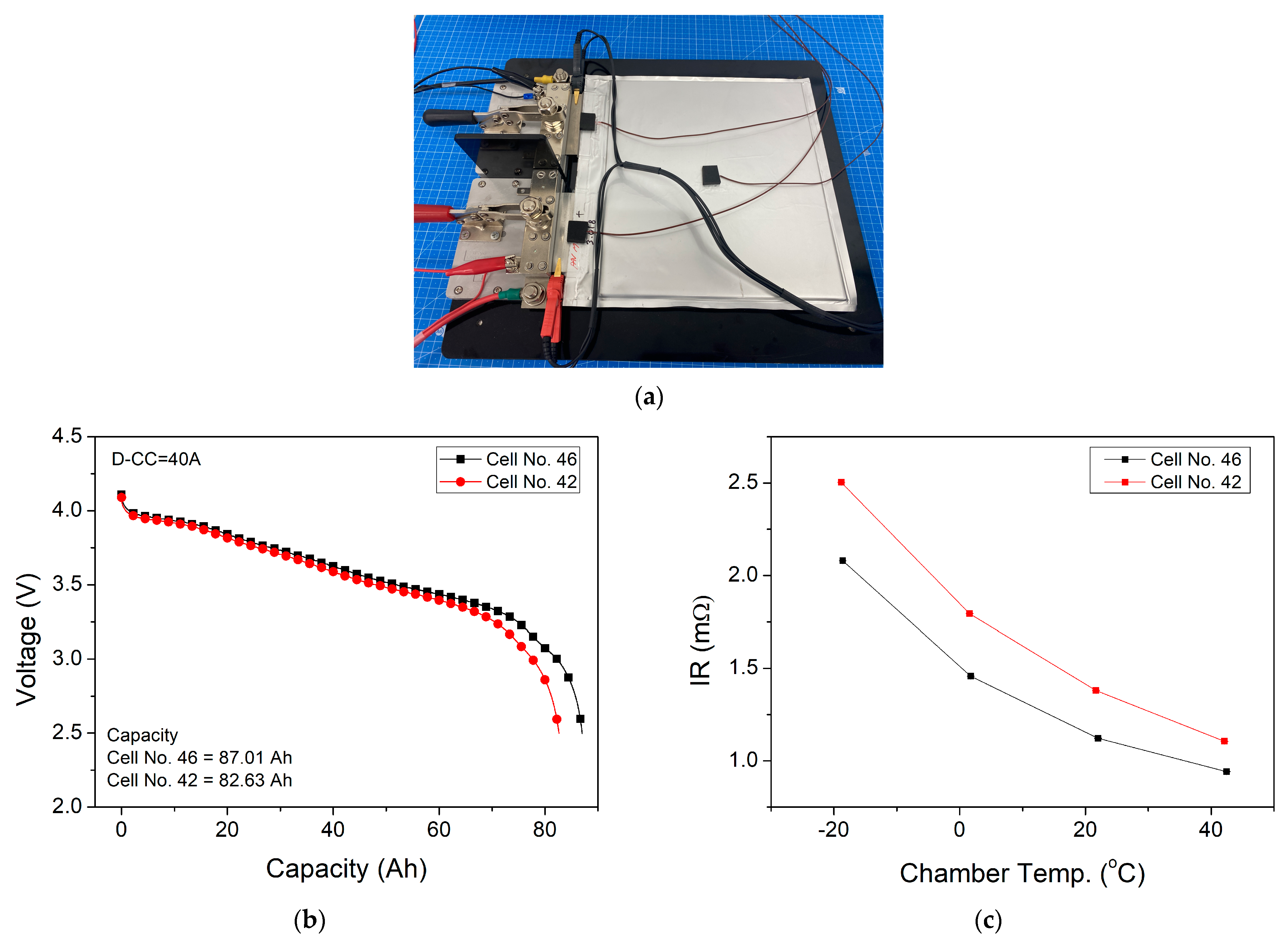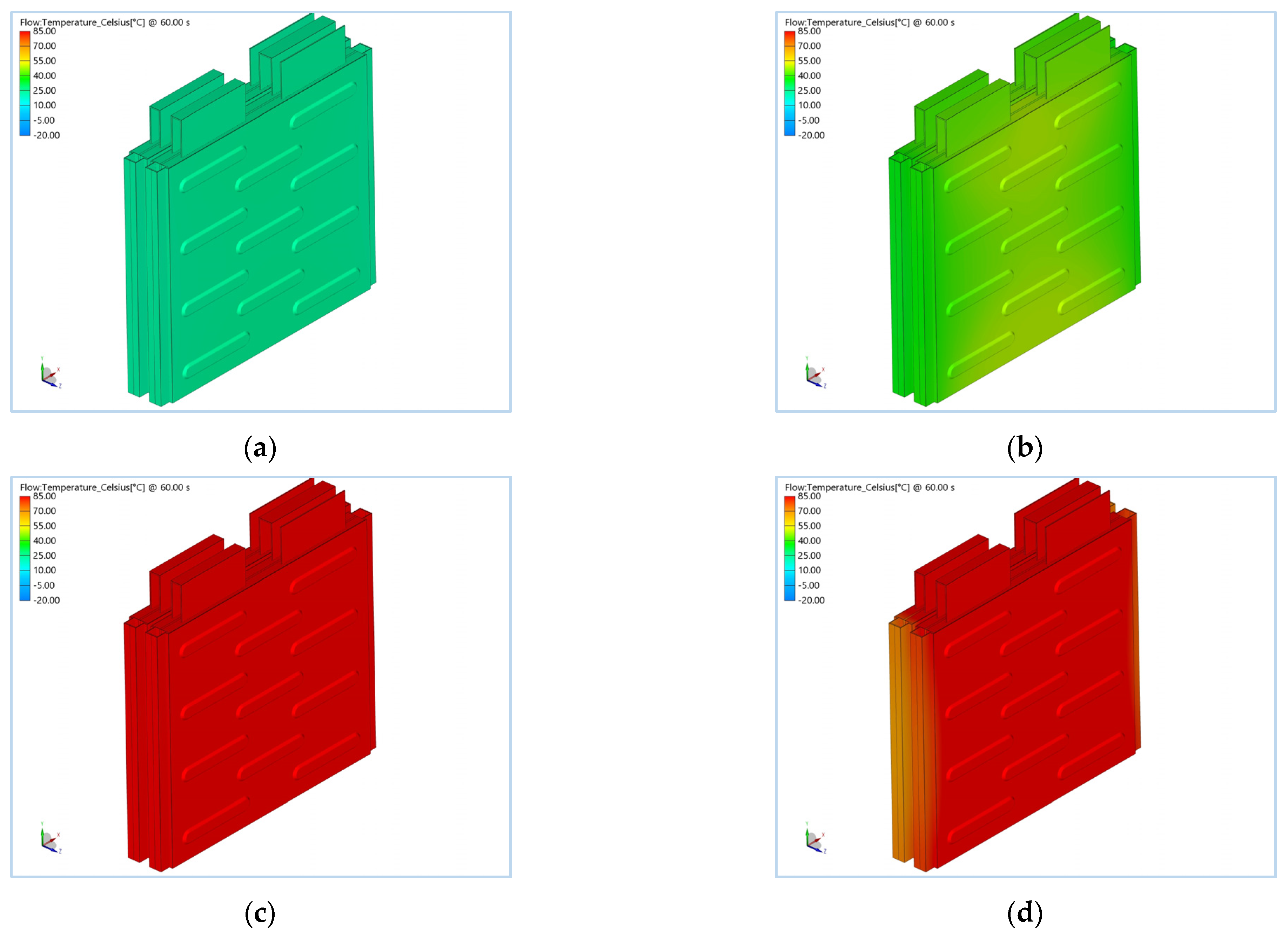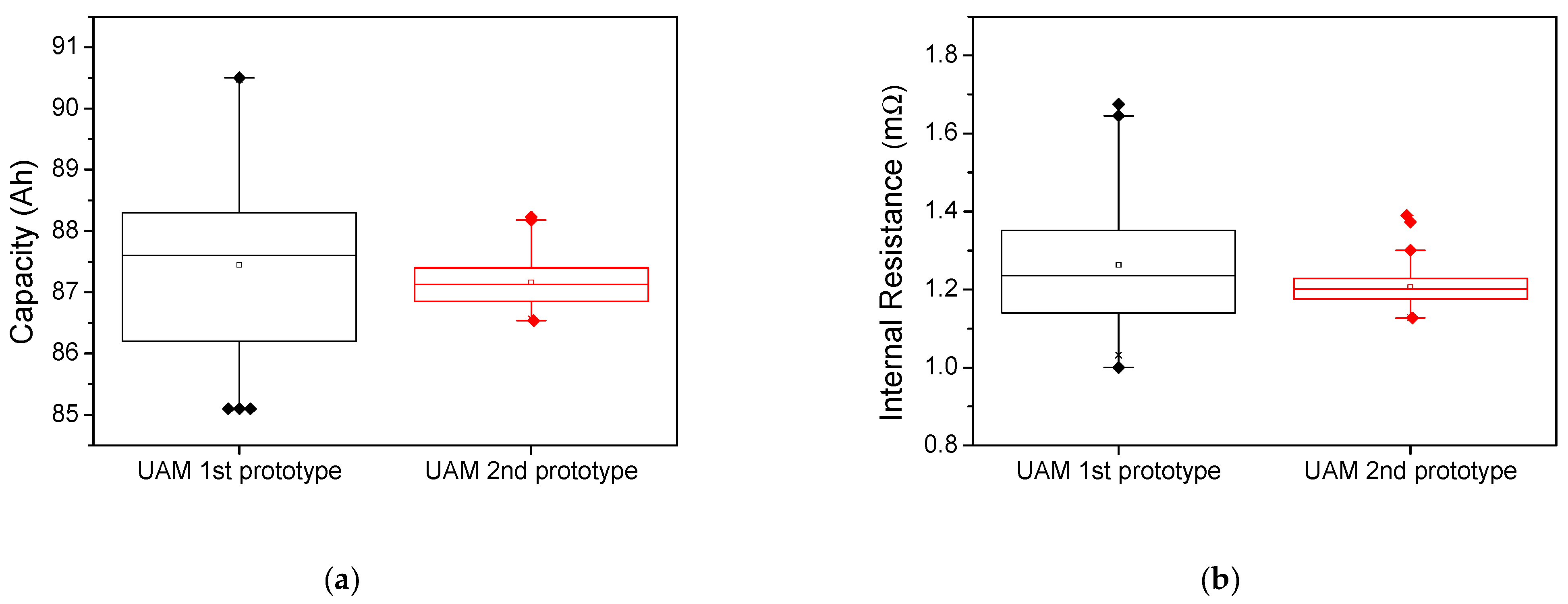1. Introduction
Urban air mobility (UAM) is a future air transport system that safely and conveniently transports passengers and cargo in the city center. It is expected to be a new means of transportation as collision avoidance and autonomous flight technologies develop along with the development of batteries with high energy density and high-efficiency motor technology [
1,
2]. The battery modules for UAM must be developed with careful consideration of power, energy density, safety, durability, and charging time, as these factors significantly impact the direct operating cost (DOC), which is essential for the commercialization of UAMs [
3]. The cell-to-pack packaging efficiency of UAM batteries is approximately 60–70%, and based on this efficiency, battery cells with an energy density of over 300 Wh/kg are being developed [
3,
4]. As high discharge characteristics are required when UAM takes off and lands, a design that considers the heating characteristics due to high discharge along with the packaging design of the battery module is becoming increasingly important [
5]. In addition, it is essential to develop a battery management system (BMS) that can effectively monitor and control the voltage and temperature of cells constituting the UAM battery module. When a battery module composed of multiple lithium-ion battery cells is discharged at a high rate, inter-cell performance characteristics caused by the capacity and internal resistance deviations of cells constituting the battery module greatly affect the overall performance of the battery module. The deviation between cell capacity and internal resistance inevitably occurs in the process of manufacturing a battery cell, and the deviation of cells occurring after battery operation affects the battery performance and the deviation of heat generation between cells, resulting in overall performance degradation. Accordingly, there is a need for a technology to predict cell performance, deviations throughout the module, and corresponding responses. A change in the capacity and state of health (SoH) of the cells and a difference in internal resistance, which are inevitably caused in the process of manufacturing lithium-ion battery cells, affect the life of the battery module in which the cells are assembled. In general, a battery module for energy storage systems (ESSs) or electric vehicles (EVs) configures a plurality of lithium-ion batteries in series or in parallel, depending on the target applications. In general, battery cells configured in parallel are more difficult to monitor and manage deviations between cells than battery cells configured in series. When lithium-ion battery cells are connected in parallel, the current of the cell is imbalanced because it is difficult to measure and manage the current deviation. Therefore, when manufacturing a battery module, it is necessary to affect and manage it, and many related studies are being conducted.
Many researchers have studied the differences between battery cells and how they change over time and affect battery life and performance as a result. Paul et al. [
6] studied the battery cells connected in series were studied to consider the capacity, initial internal resistance, life rate and heat of the initial battery cells. The analysis showed that the non-uniformity of cell aging was due to the current distribution of the non-uniform cells. Chiu et al. [
7] focused on the series of battery cells, and it was confirmed that the decrease in battery capacity increased as temperature changed. Many studies have been conducted on battery cells configured in parallel. Offer et al. [
8] reported that the contact resistance of the two internal cells was the cause of the non-uniform current flowing inside the pack. This led to a non-uniform load of each cell. Bruen and Macro [
9] experimentally evaluated the imbalance of parallel cells. It was confirmed that a difference of 30% in impedance caused a change of 60% of the peak cell current and 6% during the cycle. Fernandez et al. [
10] confirmed that the initial SoH 40% deviation decreased to 10% after 500 cycles because a lithium-ion battery experiment connected in parallel at 25 °C. Shi et al. [
11] investigated parallel LIFePO4 current imbalance. Rapid aging could reduce the imbalance by suppressing changes in temperature and current. Gong et al. [
12] showed a large deviation between cells when discharging cells with different levels of deterioration composed of parallel, which could accelerate aging and lead to serious problems. Liu et al. [
13] applied a thermal single-particle model to a parallel battery and found an irregular overpotential caused by internal connections and temperature gradients that affected the battery pack. Song et al. [
14] analyzed the current, degradation rate, state of charge (SoC), and heat dissipation between cells using a thermal, electrical aging model and compared the long-term capacity.
Until now, numerous studies have been carried out on the impact of cell-to-cell variations in lithium-ion batteries connected in parallel on the overall electrical behavior of the module, SoC, degradation due to temperature variations, and SoH. The final structure of the UAM battery module in this research aims to configure 14 lithium-ion battery cells with a capacity of 90 Ah and an energy density of 300 Wh/kg in series. The target battery module will undergo high discharge under external temperature conditions ranging from −20 °C to 43 °C. Notably, the increase in internal resistance variation between cells at low temperatures significantly affects the temperature imbalance among cells, leading to a reduction in overall module performance; therefore, this must be carefully considered during battery module production. In this study, 109 lithium-ion battery prototypes were initially produced for UAM battery module development. Two sample cells from the first prototypes were selected for experiments to measure internal resistance under various temperatures and were modeled for further analysis. Based on this data, a 4S series submodule was modeled. A lithium-ion battery submodule was then assembled, simulations were conducted, and the temperature imbalance during battery module operation was predicted.
3. Simulation Results
Figure 4 depicts the final heat release in the cell according to the outside temperature change and C-rate change through steady-state analysis of a battery module. As illustrated in the experiment result of
Figure 3b, as the internal resistance of a lithium-ion battery increases as the temperature decreases, the heating value also increases. However, when the internal temperature of the cell increased due to heat generation, the internal resistance of the cell also decreased, and the total heat generation also decreased, and the total heat generation had a constant value, as shown in
Figure 4a. Based on the outside temperature of 20 °C, the heat generation of cell #1 was 71.4 W, and that of cell #4 was 60.1 W. In the case of 20 °C or higher, the change in the heating value was not large.
Figure 4b shows the calorific value according to the outside temperature and C-rate changes, and the heat generation increases significantly as the C-rate increases. In the case of the same cell, the deviation of the internal resistance of the cell and the deviation for the C-rate were larger than the effect of the calorific value for temperature. In this study, the maximum heat generation of cell #1 under the 8 C condition was 4569.3 W, and the maximum heat generation of cell #4 was 3846.7 W. This was a value predicted during continuous discharge at 8 C condition, and the system was stopped before that because a thermal runaway occurred during the actual operation.
Figure 5 shows the change of heating value over time in cells #1 and #4 under the outside temperature and C-rate conditions and shows the results of the transient analysis. The battery submodule generated heat in the cell according to the external air condition, the operating condition, and the C-rate. Therefore, it can be seen commonly that the initial heat generation increased significantly when the temperature of the cells in both cells decreased. The heat generation inside the cell gradually increases the temperature of the cell, thereby reducing the internal resistance of the cell. As a result, the heat generation of the entire cell was also gradually reduced. The figure shows that when the temperature reached 20 °C, there was little change in the internal resistance, and the heating value was maintained constant. As shown in
Figure 5b, when the C-rate was increased to 8 C, the heating value or the temperature of the cell was greatly increased, resulting in a significant increase in the temperature of the cell, which resulted in a faster convergence of the heating value change. When high discharge was performed at a low temperature, an electrochemical reaction was slowed inside the cell and heat generation was accompanied by a large internal resistance.
Figure 6 shows the result that the battery module surface temperature distribution after 1 min according to the C-rate change at an external temperature of 20 °C is predicted. As the cell discharged at the initial stage, the temperature rose due to the heat generated inside the cell, and the heat transferred along the thin aluminum plate surrounding the submodule was cooled through heat transfer with external air. The tab had a structure in which the temperature was increased by heat conduction by heat generation inside the cell, and heat transfer with external air was cooled by heat conduction by heat generation inside the tab.
Figure 7 depicts the graph that predicts the average cell temperature and the temperature change in the tab, depending on the C-rate of the battery submodule according to the outside temperature change for 1 min. Since the heat generation was significant at low temperatures, the temperature rose significantly instantaneously, and after that, the temperature gradually rose gradually. Since the internal resistance of the tap was constant according to the temperature change, a gentle temperature increase was shown in the entire operation range. The heat generated by the cell was conducted to the tab, which increased the temperature as heat generated by its own resistance was added. The higher the discharge at low temperatures, the steeper the rise in the temperature curve of the initial cell. These characteristics can be seen because of reflecting the characteristics of internal resistance according to temperature. When the outside temperature reached 40 °C, the effect on the internal resistance was already small, so the temperature increase also had a gentler characteristic.
Table 3 summarizes the results of the average temperature difference between the cells after 1 min according to the outside temperature and the C-rate change. The average temperature difference between cells increased as C-rate increased at the same ambient temperature and decreased as the temperature increased at the same C-rate. It was predicted that a maximum of 32.952 °C temperature deviation would occur under −20 °C during the 8 C condition.
Based on the study on the temperature deviation of the internal resistance of the cells for manufacturing the UAM battery module, the product deviation between the cells was improved. The results are shown as a box plot in
Figure 8.
4. Conclusions
As a study to develop a UAM battery module using pouch-type lithium-ion battery cells, a submodule composed of four cells composed of different internal resistances was constructed, and the thermal behavior performance according to the outside temperature and C-rate changes in the internal resistance deviation of the cell was examined. The initial heat generation of a lithium-ion battery increased as its internal resistance increased at low temperatures. There was little change in the internal resistance of the cell as the temperature increased. Since the heat generation was large at low temperatures, the temperature rose significantly after the temperature increased significantly. At low temperatures, especially as a high discharge was performed, a steeper temperature rise curve of the initial cell could be seen due to the reflection of the characteristics of internal resistance according to the temperature. When the outside temperature reached 40 °C, it had a constant internal resistance, so the rise in temperature also had a gentler characteristic. The average temperature differential between cells increased with higher C-rates and similarly escalated as the ambient temperature decreased under constant C-rate. The maximum temperature deviation of 32.952 °C was predicted at −20 °C during an 8 C-rate discharge. Based on the analysis of temperature deviations and internal resistance among cells in the manufacturing process of the UAM battery module, measures were implemented to reduce product variability between cells.

















